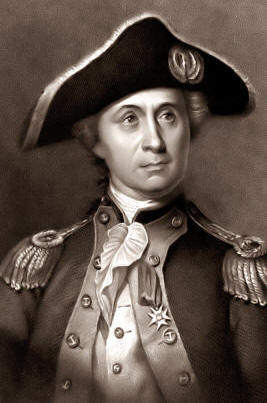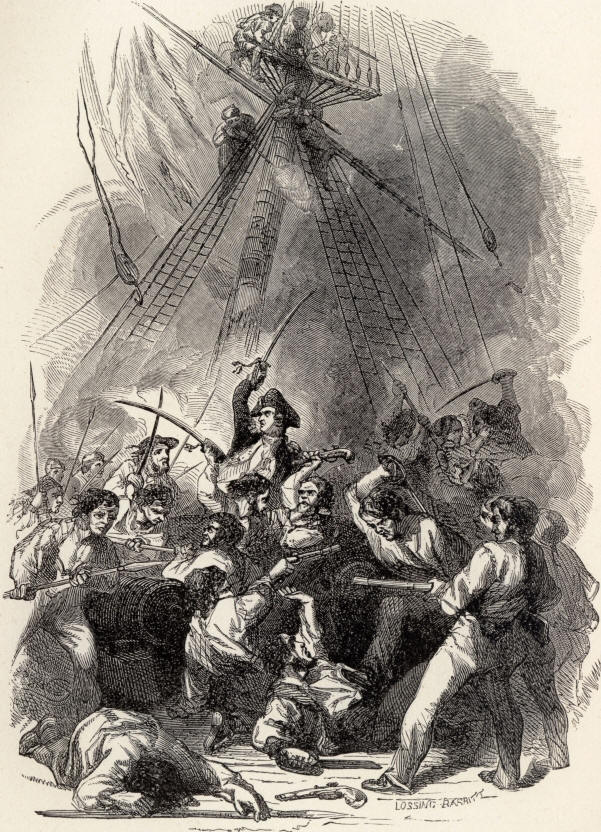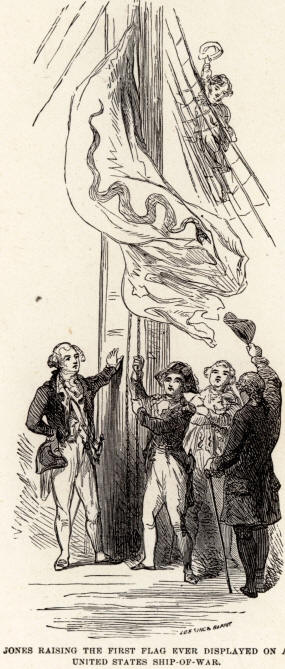John Paul Jones
|
|
This Site:
|
In 1779, while cruising up and down the east coast of Scotland, between the Solway and the Clyde, he tried to capture the Earl of Selkirk, in order to secure a notable prisoner for exchange. He had been an early friend of Jones's father. His seat was at the mouth of the Dee. Jones anchored his vessel, the Ranger, in the Solway at noon, and with a few men, in a single boat, he went to a wooded promontory on which the earl's fine estate lay, where he learned that his lordship was not at home. Disappointed, he ordered his men back to the boat, when his lieutenant, a large and fiery man, proposed to go to the mansion and plunder it of the family plate. Jones would not listen to the proposition, for the memory of old associations made his heart tender towards Lady Selkirk, who had been very kind to him. Again he ordered his men back, but they and the lieutenant, eager for prize-money, in defiance of his expostulations, went to the house and demanded the plate. The frightened Lady Selkirk surrendered it with her own hands. When the prizes of the Ranger were sold Jones bought this plate, and sent it back to Lady Selkirk with a letter in which he expressed his regret because of the annoyance she had suffered.
THE HAND-TO-HAND FIGHT ON THE DECK OF THE SERAPIS.During the spring and summer of 1779, American
cruisers were very active, both in American and European waters. At
the middle of August Jones was sent out from the French port of
L'Orient, with five vessels, to the coast of Scotland. His flagship
was the Bon Homme Richard. As he was about to strike some armed
British vessels in the harbor of Leith a storm arose, which drove
him into the North Sea. When it ceased, he cruised along the
Scottish coast, capturing many prizes and producing great alarm.
Late in September, while Jones's squadron lay a few leagues north of
the mouth of the Humber, he discovered the Baltic fleet of forty
merchantmen (convoyed by the Serapis, a 44-gun ship, and the
Countess of Scarborough, of twenty-two guns), stretching out from
Flamborough Head. Jones signaled for a chase, and all but the
Alliance, Captain Landais, obeyed. While the opposing warships were
maneuvering for advantage, night fell upon the scene. At seven
o'clock in the evening of September 23, 1779, one of the most
desperate of recorded sea-fights began. The Bon Homme Richard and
Serapis, Captain Pearson, came so close to each other that their
spars and rigging became entangled, and Jones attempted to board his
antagonist. A short contest with pike, pistol, and cutlass ensued,
and Jones was repulsed. The vessels separated, and were soon placed
broadside to broadside, so close that the muzzles of their guns
touched each other. Both vessels were dreadfully shattered: and, at
one time, the Serapis was on fire in a dozen places. Just as the
moon rose, at half-past nine o'clock, the Richard, too, caught fire.
A terrific hand- |
|
|
||
|
|
Site Copyright 2003-2018 Son of the South. For Questions or comments about this collection, contact: paul@sonofthesouth.net |
|
|
Are you Scared and Confused? Read My Snake Story, a story of hope and encouragement, to help you face your fears. |
||
 Jones,
JOHN PAUL, naval officer; born in Kirkbean, Scotland,
July 6, 1747. Before he was eighteen years old he commanded a vessel
that traded with the \Vest Indies. Jones came to
Jones,
JOHN PAUL, naval officer; born in Kirkbean, Scotland,
July 6, 1747. Before he was eighteen years old he commanded a vessel
that traded with the \Vest Indies. Jones came to

 to-hand
fight now ensued. Jones's ship, terribly damaged, could not float
much longer. The flames were creeping up the rigging of the Serapis,
and by their light Jones saw that his double-headed shot had cut the
mainmast of the Serapis almost in two. He hurled another, and the
tall mast fell. Pearson saw his great peril, hauled down his flag,
and surrendered. As he handed his sword to Jones he said, in a surly
tone, "It is painful to deliver up my sword to a man who has fought
with a rope around his neck!" (Jones had been declared a pirate by
the British government.) The battle ceased, after raging three
hours. The vessels were disengaged, and the Richard soon went to the
bottom of the North Sea. For this victory Congress gave Jones the
thanks of the nation, a gold medal and a commission as commander of
the America, which ship was soon presented to France. The King of
France made Jones a knight of the Order of Merit, and presented him
with a gold sword. Jones entered the service of Russia as
rear-admiral in 1787, and, in consequence of a victory over the
Turks, was made vice-admiral and knighted. He resigned from the
Russian service, and was appointed consul of the United States at
Algiers in 1792, but he died before the commission reached him. He
died in Paris, July 18, 1792. His body was brought back to the
United States by a squadron of war-ships in June, 1905.
to-hand
fight now ensued. Jones's ship, terribly damaged, could not float
much longer. The flames were creeping up the rigging of the Serapis,
and by their light Jones saw that his double-headed shot had cut the
mainmast of the Serapis almost in two. He hurled another, and the
tall mast fell. Pearson saw his great peril, hauled down his flag,
and surrendered. As he handed his sword to Jones he said, in a surly
tone, "It is painful to deliver up my sword to a man who has fought
with a rope around his neck!" (Jones had been declared a pirate by
the British government.) The battle ceased, after raging three
hours. The vessels were disengaged, and the Richard soon went to the
bottom of the North Sea. For this victory Congress gave Jones the
thanks of the nation, a gold medal and a commission as commander of
the America, which ship was soon presented to France. The King of
France made Jones a knight of the Order of Merit, and presented him
with a gold sword. Jones entered the service of Russia as
rear-admiral in 1787, and, in consequence of a victory over the
Turks, was made vice-admiral and knighted. He resigned from the
Russian service, and was appointed consul of the United States at
Algiers in 1792, but he died before the commission reached him. He
died in Paris, July 18, 1792. His body was brought back to the
United States by a squadron of war-ships in June, 1905.